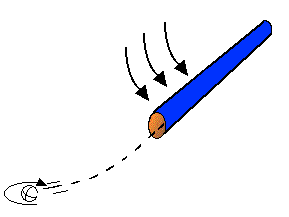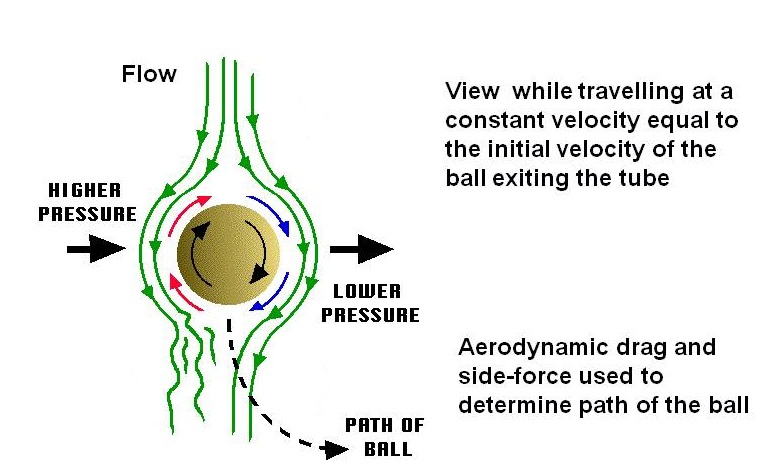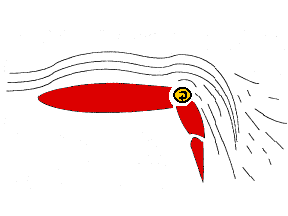PING
PONG BALL CURVES
SUBJECT: Aeronautics
TOPIC: Lift
DESCRIPTION: A ping pong ball is tossed with a rapid spin causing it
to curve in flight.
CONTRIBUTED BY: Demonstrations and Laboratory Experiences in The Science
of Aeronautics, Civil Aeronautics Administration and American Council on Education
(1945)
EDITED BY: Roger Storm, NASA Glenn Research Center
MATERIALS:
Two cardboard mailing tubes of a greater diameter
than a ping pong ball
1 sheet of medium sand paper
Ping pong ball
White glue
Magic Marker
Ruler
Knife
PROCEDURE:
1. Cut a 2 foot length from the mailing tube.
2. Roll up the sheet of sand paper, with the grit to the inside, into a tube.
Check to see that the ping pong ball will still roll in the tupe with the
sandpaper in place. Remove the sandpaper, spread white glue in several places
and slide the sand paper back into the mailing tube so that the sand paper
is flush with one end. Let the glue dry.
3. Use a marker to make two circles around the ball at right angles with each
other. These lines will help you see the spin of the ball.
THROWING:
1. Practice throwing ping pong ball curves in an open place.
2. Hold the tube with your throwing hand at the end opposite the sand paper.
Drop the ping pong ball in the tube.
3. Quickly swing the tube horizontally through the air. The ball will shoot
out the tube and curve through the air as it flies forward.

4. Repeat step 3, but use a piece of mailing tube with no sandpaper
on the inside and note the results.
5. Now repeat both steps 3 and 4, but use your other hand to throw
the ball so that it spins in the opposite direction and note the new results.
DISCUSSION:
The mailing tube makes
it easy to achieve a "major league" curve pitch with a ping pong ball. As
the ball is thrown from the tube, the ball rubs against the sand paper on
the side of the tube from the direction the tube is moving. Friction from
the sand paper on the ping pong ball causes it to spin rapidly in a clockwise
direction for right-handed throws and counterclockwise for left handed throws.

As the ball spins, the surface friction of the ball with the surrounding air
drags a thin layer of air with it. This is referred to as the boundary layer.
At the same time the ball spins, it is moving forward. On one side of the
ball, the boundary layer air is traveling in the same direction as the air
stream that is flowing around the ball (the blue arrows). On the other side,
it is traveling in the opposite direction (the red arrows). On the side of
the ball where the air stream and boundary layer air are moving opposite to
each other friction between the two slows the air stream. On the opposite
side the layers are moving in the same direction and the stream moves faster.
According to Bernoulli's Principle, faster moving air exerts less pressure,
so the ball is pushed and it curves to the right for right-handed throws.
Left-handed throws produce a curve to the left. .
A practical application
for this curving effect is a rotating cylinder flap for an airplane wing.

A rotating cylinder is mounted in the joint between a wing and its flaps.
During low speed operation, the cylinder spins rapidly in the same direction
as the air stream. Boundary layer air is bent down-ward over the steeply angled
flap. This increases lift for the wings and delays the buildup of turbulence
conditions that could lead to a stall.
Return to Aeronautics Activities
Return to Aerospace Activities Page
Objects that Lift
Curve Ball Aerodynamics
Curve Ball Trajectory
Object Motion under a Central Force
Aerospace Education Services
Project
Oklahoma State University
